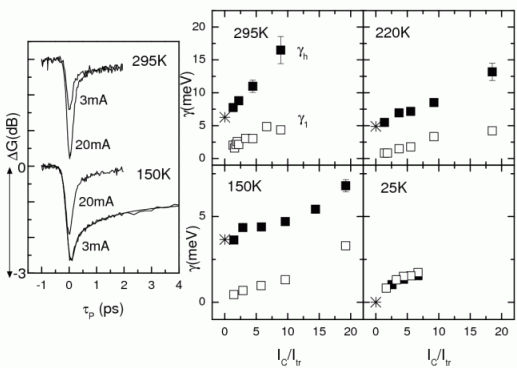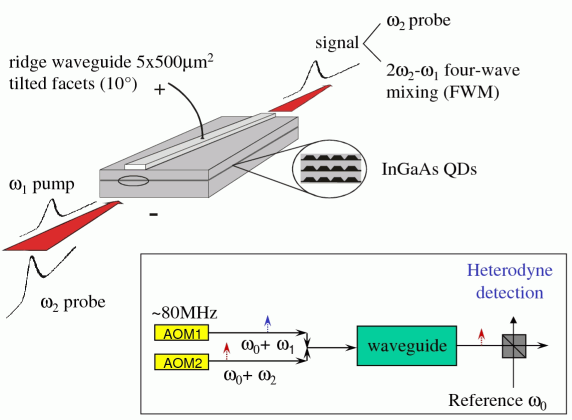|
Semiconductor optical
amplifiers
(SOAs) are considered important devices for optical communications
being low cost, having small size, high gain, and large amplitude and
phase nonlinearities. However, slow dynamics of the gain nonlinearities
in conventional bulk and quantum-well SOAs (mainly due to carrier
heating) usually limits the performance of these amplifiers for optical
signal processing at high bit rates. SOAs with InGaAs quantum dots
(QDs) in the active region have recently attracted increasing attention
because of their ultrafast gain recovery dynamics (dominated by
spectral hole burning nonlinearities) [1] and suppression of pattern
effects in amplification and cross-gain modulation for 10–40-Gb/s
signals [2]. Fast carrier relaxation into the QD active states is a key
feature for ultrafast optical signal processing with QD-based SOAs. In
addition to carrier relaxation dynamics, the knowledge of the dephasing
time, inversely proportional to the homogeneous broadening of the
optical transition in QD lasers/amplifiers under working conditions
(i.e at room temperature and under electrical injection) is crucial for
a realistic modelling of the performances of QD devices that rely on a
delta-function-like density of states.
[4] P. Borri et al. J. Opt. A: Pure Appl. Opt. 8 S33-S46
(2006) (Special Issue Review Article).
We have developed a pump-probe spectroscopy technique based on a heterodyne detection (see Fig.1) that allows us to measure the ultrafast gain recovery dynamics and dephasing processes in QD SOAs as a function of temperature and electrical injection (see Fig.2). With this technique we also monitor the dynamics of the pump-induced refractive index changes which can be expressed in terms of a transient alpha parameter [3] (see Fig.3). A recent review of our most important results on InGaAs QD SOAs is given in [4]. Our current research aim is to address the gain dynamics and dephasing processes on a variety of QD SOAs for a comparative study. This includes undoped and p-doped InGaAs QDs emitting at 1.3micron wavelength at room temperature but also InGaP QDs emitting in the red-visible (~650nm) wavelength region. [1] P. Borri et al. IEEE Photon. Techn. Lett. 12, 594 (2000), IEEE J. Sel. Topics in Q. El. 8, 984-991 (2002). [2] M. Sugawara et al. J. Phys. D: Appl. Phys. 38, 2126–2134 (2005). [3] S. Schneider et al. IEEE J. Quantum El. 40, 1423 (2004). |
|
 Figure 2. Gain recovery dynamics of an InGaAs quantum-dot amplifier (See [1,4]). |
 Figure 3. Transient alpha parameter of an InGaAs quantum-dot amplifier using the heterodyne technique (See [3]). |
